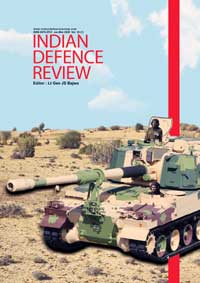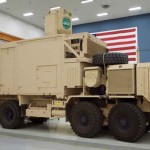Thus force levels can be rapidly built up at a fraction of the cost of as many combat jets. Such AI-endowed wingmen may fly independently or in support of manned aircraft, while maintaining a safe distance. They can also be sent ahead of the combat jet to draw enemy fire – like sacrificial lambs. The pilot’s workload is, of course, a major concern that is being addressed. And super-reliable communications will be required to ensure that the link between the leader and the unmanned wingmen is not snapped or compromised.
Drones are also highly vulnerable to air and ground fire…
Surface Revolution
Future ground forces, even infantry personnel, will make extensive use of small and nano drones. Hence, light and flexible systems will be preferred. The US Army has already awarded a contract for the Black Hornet Personal Reconnaissance System – a miniature helicopter with video cameras which enables infantry squads to see enemy units from the air. It weighs as little as a parakeet and can shoot live video at short ranges using either a daylight imager or infrared. Its endurance is 25 minutes.
The latest trend for such small UAVs is nature-inspired designs like common birds or insects which would confuse ground observers. For instance, a Russian owl-shaped drone intended to track tanks, vehicles and other heavy equipment, has an electric motor for quiet flight. It carries a laser target designator to illumine targets and then direct fire against them.
In February this year, the world famous Russian weapons manufacturer Kalashnikov revealed its KUB-UAV high-precision attack system – a tiny suicide drone designed to destroy remote ground targets by exploding into them. The KUB-UAV is very quiet, highly accurate and carries a three-kg explosive charge to strike targets up to 64km away. Its price tag will be fairly low, making it possible for even relatively impoverished armies to acquire.
AI and autonomy are the keys to the successful employment of both drone swarms and MUT…
Among naval forces, rotor-powered vertical take-off drones are quickly gaining popularity over fixed-wing systems which need a runway. Also, commercial drone research and investment is mainly focussed on quadcopter devices and most technological advances are being made in such types. Therefore, military forces with tight budgets can at least hope to equip themselves with civilian drones modified to meet their requirements.
Counting on Counter-measures
And yet even advanced drones have severe limitations, mainly on account of their restricted field of view. The airborne pilot has a wide-angle view of the target as well as its surroundings which helps to contextualise the task and to decide whether or not to press home the attack. A remote drone pilot, in contrast, has a crystal-clear view of the specific target, but may be ignorant as to what lies even a small distance away. Hence, the chances of fratricide during say, a Close Air Support (CAS) mission, are much higher. Although autonomous drones can be programmed to cope with a variety of situations, they cannot handle the unexpected.
Drones are also highly vulnerable to air and ground fire. As is inevitable in military affairs, even as one set of technologists endeavours to make UAVs smaller and lighter as well as more capable and lethal, another lot is determined to develop more effective ways of shooting them down or at least deflecting them. Possible countermeasures to drones include High Powered Microwave (HPM) and High Powered Laser (HPL) systems, Electronic Warfare (EW), cyber-attacks, accurate small arms fire and counter-drone swarms.
Future UAVs will be more capable than ever with higher speeds, greater ranges, more manoeuverability and more stealth than today’s systems.
Against small drones, IXI EW has developed a special rifle called Dronekiller. It can function in stand-alone mode or as an attachment to a regular rifle. And the Israeli company Smart Shooter is producing SMASH 2000 Plus – a fire control system with an anti-drone mode. However, armies in the next decade that equip their infantry soldiers with drones and anti-drone systems may have to grapple with the question of what equipment to remove from the existing kit to make way for these items. Alternatively, they may decide to introduce one or more specialist drone operators responsible for the unit’s UAVs as well as its anti-drone systems.
At present, drones have the upper hand in this cat-and-mouse game. The defender will find the going even tougher when drone swarms and loyal wingmen materialise because even the most advanced current AD system cannot cope with large numbers of simultaneous intruders.
Anytime, Anywhere Intelligent Warfare
AI and autonomy are the keys to the successful employment of both drone swarms and MUT. In fact, autonomous weapons in general are expected to usher in the next technological revolution in warfare, after the invention of gunpowder and the development of nuclear weapons. That is why China lays great emphasis on AI. It has resolved to overtake the US in AI by 2025 and become the dominant world force by 2030.
Drones have been called “the ultimate military growth industry”. Air, naval and land forces everywhere are striving to acquire these platforms. Herein lies the danger; thanks to advanced armed drones, aggression is becoming pain-free. Practically every military that has inducted UCAVs has sought to purchase even more of them and employ them with increasing frequency. This is because armed drones are seen as a way to coerce the adversary without the risk of body-bags. Even the sixth-generation combat jets now in the conceptual stage, may be only optionally manned.
The transformational potential of AI-endowed unmanned systems on air operations is immense. Future UAVs will be more capable than ever with higher speeds, greater ranges, more manoeuverability and more stealth than today’s systems. UCAVs will offer greater accuracy and lethality coupled with autonomy. Unmanned systems will provide the means to conduct aerial operations anywhere in the world and at any time, with or without human beings in the loop.






The “box” misses out to enter in the cons list hand held jammers of the size of mobile phones which can easily confuse the attacking drones to miss their targets or become useless for gathering the intelligence information to transmit back. Also, the drones fly low and can be destroyed by ground fire or anti-aircraft guns. Thus these gadgets can be rendered virtually useless in the battle field when the defender is geared up with adequate countermeasures.